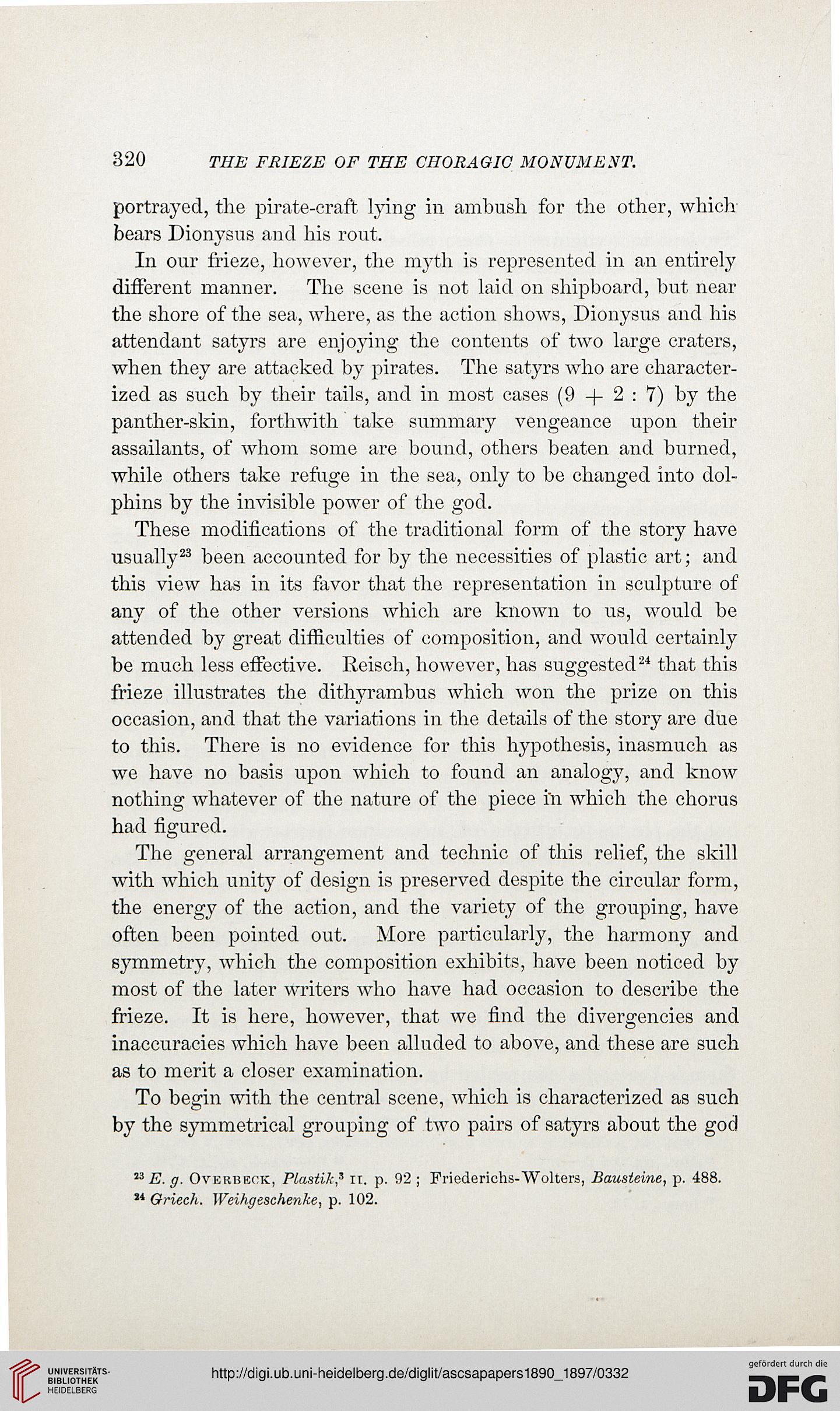320
THE FRIEZE OF THE CIIORAGIG MONUMENT.
portrayed, the pirate-craft lying in ambush for the other, which
bears Dionysus and his rout.
In our frieze, however, the myth is represented in an entirely
different manner. The scene is not laid on shipboard, but near
the shore of the sea, where, as the action shows, Dionysus and his
attendant satyrs are enjoying the contents of two large craters,
when they are attacked by pirates. The satyrs who are character-
ized as such by their tails, and in most cases (9 -f 2 : 7) by the
panther-skin, forthwith take summary vengeance upon their
assailants, of whom some are bound, others beaten and burned,
while others take refuge in the sea, only to be changed into dol-
phins by the invisible power of the god.
These modifications of the traditional form of the story have
usually23 been accounted for by the necessities of plastic art; and
this view has in its favor that the representation in sculpture of
any of the other versions which are known to us, would be
attended by great difficulties of composition, and would certainly
be much less effective. Reisch, however, has suggested24 that this
frieze illustrates the dithyrambus which won the prize on this
occasion, and that the variations in the details of the story are due
to this. There is no evidence for this hypothesis, inasmuch as
we have no basis upon which to found an analogy, and know
nothing whatever of the nature of the piece in which the chorus
had figured.
The general arrangement and technic of this relief, the skill
with which unity of design is preserved despite the circular form,
the energy of the action, and the variety of the grouping, have
often been pointed out. More particularly, the harmony and
symmetry, which the composition exhibits, have been noticed by
most of the later writers who have had occasion to describe the
frieze. It is here, however, that we find the divergencies and
inaccuracies which have been alluded to above, and these are such
as to merit a closer examination.
To begin with the central scene, which is characterized as such
by the symmetrical grouping of two pairs of satyrs about the god
53 E. g. Overbeok, Plastik,* ii. p. 92 ; Friederichs-Wolters, Bausieine, p. 488.
'* Griech. Weihgeschenke, p. 102.
THE FRIEZE OF THE CIIORAGIG MONUMENT.
portrayed, the pirate-craft lying in ambush for the other, which
bears Dionysus and his rout.
In our frieze, however, the myth is represented in an entirely
different manner. The scene is not laid on shipboard, but near
the shore of the sea, where, as the action shows, Dionysus and his
attendant satyrs are enjoying the contents of two large craters,
when they are attacked by pirates. The satyrs who are character-
ized as such by their tails, and in most cases (9 -f 2 : 7) by the
panther-skin, forthwith take summary vengeance upon their
assailants, of whom some are bound, others beaten and burned,
while others take refuge in the sea, only to be changed into dol-
phins by the invisible power of the god.
These modifications of the traditional form of the story have
usually23 been accounted for by the necessities of plastic art; and
this view has in its favor that the representation in sculpture of
any of the other versions which are known to us, would be
attended by great difficulties of composition, and would certainly
be much less effective. Reisch, however, has suggested24 that this
frieze illustrates the dithyrambus which won the prize on this
occasion, and that the variations in the details of the story are due
to this. There is no evidence for this hypothesis, inasmuch as
we have no basis upon which to found an analogy, and know
nothing whatever of the nature of the piece in which the chorus
had figured.
The general arrangement and technic of this relief, the skill
with which unity of design is preserved despite the circular form,
the energy of the action, and the variety of the grouping, have
often been pointed out. More particularly, the harmony and
symmetry, which the composition exhibits, have been noticed by
most of the later writers who have had occasion to describe the
frieze. It is here, however, that we find the divergencies and
inaccuracies which have been alluded to above, and these are such
as to merit a closer examination.
To begin with the central scene, which is characterized as such
by the symmetrical grouping of two pairs of satyrs about the god
53 E. g. Overbeok, Plastik,* ii. p. 92 ; Friederichs-Wolters, Bausieine, p. 488.
'* Griech. Weihgeschenke, p. 102.




